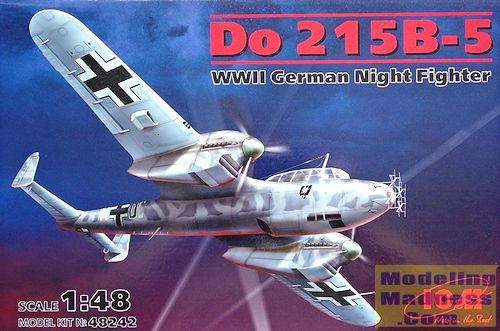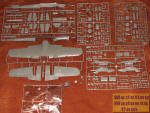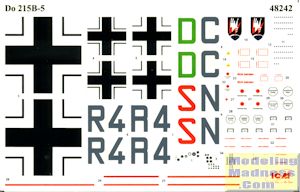
ICM 1/48 Do-215B-5 Night Fighter
| KIT #: | 48242 |
| PRICE: | $59.99 SRP |
| DECALS: | Two options |
| REVIEWER: | Scott Van Aken |
| NOTES: |

| HISTORY |
The Do 17 fast bomber elicited renewed interest from foreign air forces (after the initial Do 17K series production). In July 1937, Dornier therefore prepared a pre-series Do 17 Z-0 as a demonstrator for export customers. It was given the civil registration D-AAIV. While this aircraft was essentially identical to the production Do 17Z, the Reichsluftfahrtministerium assigned the designation Do 215 to the export version. The V1 prototype retained the 9-cylinder Bramo 323 Fafnir radial engine of the Do 17Z.
The second prototype (Do 215 V2) was equipped with Gnome-Rhône 14-NO radial engines. It safely completed testing, but did not attract export orders because it did not offer a notable performance increase over the Do 17Z. Dornier therefore equipped the V3 prototype with the 1,175 PS (1,159 hp) Daimler-Benz DB 601Ba inline engines. much like the 1937 fitment of the earlier DB 600 powerplants to the Do 17L and M subtypes. The V3, which first flew in the spring of 1939, showed a noticeable improvement in flight performance compared to the earlier prototypes.
Series production of the Do 215 A-1 began in 1939. The order, intended for the Swedish Air Force, was stopped in August 1939 due to the political situation. The 18 extant aircraft were embargoed and pressed into Luftwaffe service upon the outbreak of World War II.
Some modifications were made and the resulting aircraft were redesignated Do 215B. This was the standard production version. According to official figures 105 Do 215s were produced between 1939 and 1941 by Dornier in their factory at Oberpfaffenhofen.
| THE KIT |
 ICM
has previously produced a Do-215B in 1/72 scale and so already had a lot of data
with which to do a larger scale kit. This one is the result. The tooling is
excellent with lots of nice detail. It is obvious from the 'do not use' areas on
the sprue layout chart that the regular bomber version uses the same sprues, so
it seems like all the bits are on the sprues to do this variant if
one wishes to give it a go.
ICM
has previously produced a Do-215B in 1/72 scale and so already had a lot of data
with which to do a larger scale kit. This one is the result. The tooling is
excellent with lots of nice detail. It is obvious from the 'do not use' areas on
the sprue layout chart that the regular bomber version uses the same sprues, so
it seems like all the bits are on the sprues to do this variant if
one wishes to give it a go.
Interior detail is excellent with various side consoles and instrument panels. There are decals for the instrument panels should one wish to use those. Since this is the night fighter version, the second seat is used for the radar operator and a third for the rear gunner. The kit has a full bomb bay into which one places a large fuel tank in the forward section.
The kit's wings have separate ailerons and comprises a single upper wing section with two lower wing halves. Full engines are offered on both sides and while one may want to build it with the cowlings closed, you'll still need the block and mounts in place so that you can attach the props. Each main gear well is built up of several sections and it is inside those wells that you will find the most difficult to remove ejector pin marks. The main landing gear is quite complex and part of it needs to be built before the nacelles are glued together. This will make painting a bit of a challenge. I should also mention that there is an open framework at the leading edge of the main gear mud guards. Both of mine were broken in several pieces. The engine exhausts, by the way, seem to fit from the outside, so they can be added near the end. So complex is the engine, landing gear and nacelle construction, that 35 steps and four pages of instructions are dedicated to it.
As mentioned, the aircraft comes with a full bomb bay and the
instructions would have you install the bomb racks in the aft bay. Lazy modelers
will put nothing in there but perhaps the cross braces as a closed door piece is
included with the kit. All of the clear bits are located in the front of the
fuselage with two different canopy sections being offered. A separate gun nose
is provided . This night fighter had no lower fuselage gun pack. A somewhat
thick set of radar antennas is provided. The tail section is one of the last
things to be built in this one. There are separate rudders and elevators. It
appears one could place the elevators in a position other than neutral. Period photos show them mostly
in the neutral position, but some show them drooped.
the elevators in a position other than neutral. Period photos show them mostly
in the neutral position, but some show them drooped.
Instructions are nicely done with large views of the 88 construction steps. Color information is provided with Model Master references. Both options are with II./NJG 2 operating out of Holland. One is the box art plane in RLM 74/75/76 while the other is overall black. The decals are nicely printed though the red looks a bit too bright. I've not had great success with ICM decals, but it has been a while since I've built one of their kits and perhaps those have improved.
| CONCLUSIONS |
If you are building a German night fighter collection then this one you need to have in your collection. It seems that no warring power had more different types performing this function than the Germans and this is a nice addition.
| REFERENCES |
http://en.wikipedia.org/wiki/Dornier_Do_215
December 2014 Thanks to me for picking this one
up. If you would like your product reviewed fairly and fairly quickly, please contact the editor or see other details in the
Note to
Contributors.